Culture of Yorkshire
The culture of Yorkshire has developed over the county's history, influenced by the cultures of those who came to control the region, including the Celts (Brigantes and Parisii), Romans, Angles, Vikings and Normans. Yorkshire people are said to have a strong sense of regional identity and have been viewed to identify more strongly with their county than their country.[1] The Yorkshire dialect and accent is distinctive, although use of dialect words is receding.[2]
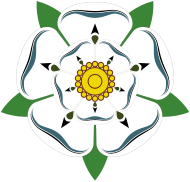

Traditions and stereotypes
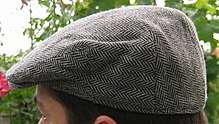
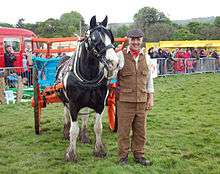
Many Yorkshire people are immensely proud of both their county and their identity, embracing the popular nickname of God's Own County given to Yorkshire.[3][4]
The most common stereotype of a Yorkshire person is as tight with money: there is a British saying that "a Yorkshireman is a Scotsman with all the generosity squeezed out of him", which references how Scots are also stereotyped as being tight but not as tight as Yorkshire folk. This stereotype can also be seen in the Yorkshireman's Motto:
- 'Ear all, see all, say nowt;
- Eyt all, sup all, pay nowt;
- And if ivver tha does owt fer nowt –
- Allus do it fer thissen.[5]
Translation: 'Hear all, see all, say nothing; Eat all, drink all, pay nothing; And if ever you do anything for nothing – always do it for yourself.
Yorkshire people are often stereotyped as friendly but "bloody-minded", stubborn (also known as "Yorkshire-stubborn") and argumentative.[6][7] Indeed, throughout the history of the area, dating from the tribal Brigantes, through the Norman period and the Wars of the Roses, the region has seen a number of rebellions against non-Yorkshire or non-Northern rulers. It is this stereotype which is referred to in the saying 'You can always tell a Yorkshireman, but you can't tell him much'. However, the popular understanding of the Wars of the Roses is mostly false. The House of York had its support mostly in southern England, while northern England on either side of the Pennines mainly supported the House of Lancaster. Indeed, the city of York itself was a Lancastrian power base.[8]
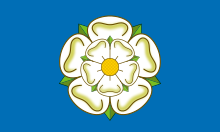
One social stereotype of a Yorkshireman had a tendency to include such accessories as a flat cap and a whippet; this alludes to rural life. While the stereotype might not always ring true, the county certainly has an illustrious rural history; many of the now prominent West Yorkshire cities grew thanks in part to the wool industry. Another stereotype often heard in connection with Yorkshire workers is the proverb "where there's muck, there's brass"; this refers to the widely held view that where one is willing to do unpalatable work, there is plenty of money to be made.[9]
Tyke or Yorkie is now a colloquialism used to identify the Yorkshire dialect, as well as the term some Yorkshiremen affectionately use to describe themselves, especially in the West Riding. Originally "tyke" was a highly derogatory word, meaning "a crude uncouth ill-bred person lacking culture or refinement"; southerners used the term against Yorkshiremen,[10] but in defiance of the negative connotations it was adopted locally, taking on a new life.[11]
.jpg)
Among Yorkshire's unique traditions is the Long Sword dance, a traditional dance not found elsewhere in England. The most famous song of Yorkshire is On Ilkla Moor Baht 'at ("On Ilkley Moor without a hat"); it is considered the unofficial anthem of the county.[12] In celebration of its culture, Yorkshire Day has been celebrated annually on 1 August since 1975. Amongst the celebrations is a civic gathering of Lord Mayors, Mayors and other civic heads from across the county, convened by the Yorkshire Society.
Food and drink
The cuisine of Yorkshire and that of Northern England in general is known for its rich ingredients, especially in sweet dishes. Below is a list of foods which either originated from Yorkshire or are strongly associated with it.
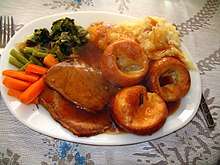
- Yorkshire pudding – far and away the most well known element of Yorkshire food, it is commonly served with roast beef, vegetables and potatoes, to form part of the standard Sunday roast, which itself grew from the county. It is created from batter and in most cases that it is eaten, the dish includes gravy.
In its traditional form, it is easily large enough to fill the plate. It is eaten before the main meal as a starter – the idea being that you would then not want to eat as much of the more expensive meat.
It can also be served as a savoury dish with onions and herbs as part of the batter mix but can also be served afterwards with jam.
It is only those from outside the county who think it must be served with the main meal.
- Yorkshire curd tart – a curd tart recipe which has been around since at least the 1750s, unique because of its use of rosewater.[13][14]
- Parkin – a sweet ginger cake which is different from standard ginger cakes in that it includes oatmeal and treacle as part of the traditional recipe.[15]
- Gingerbread, one unusual form of gingerbread from Yorkshire has a layer of crystallised ginger in the middle, rather than an essence of ginger or ginger shavings.
- Liquorice sweet – the plant was thought to have been brought over to Yorkshire by returning Crusaders or Dominican friars in the 14th century. It became synonymous with Pontefract in Yorkshire, as local man George Dunhill in the 1760s thought to mix it with sugar, creating what was known locally as "Pomfret cakes", but is now well known as "liquorice". As liquorice requires deep soil to grow, it was mainly grown in Pontefract. Although it is no longer grown in the area, Pontefract has two large confectionery factories as a legacy.[16]
- Wensleydale cheese – a cheese associated with Wensleydale in North Yorkshire; the local pastures give the cheese the unique flavour for which it is renowned
- Ginger beer – a beverage flavoured with ginger, it has existed since the mid-1700s.[17]
- Rhubarb: The Yorkshire Rhubarb Triangle is a 9-square-mile (23 km2) triangle in West Yorkshire, between Wakefield, Morley and Rothwell, famous for producing early forced rhubarb which is harvested by candlelight.[18] In February 2010, Yorkshire Forced Rhubarb was awarded Protected Designation of Origin status under the European Commission's Protected Food Name scheme after being recommended by the Department for Environment, Food and Rural Affairs, (Defra).[19]
From the 1700s onwards, Yorkshire, and in particular the city of York, saw the growth of several chocolate factories or companies, forming an important part of the confectionery industry and now with globally known products.[20][21] These include:
- Rowntree's (York) – produced Kit Kat, Smarties, Aero, Fruit Pastilles, Black Magic and Polo.
- Terry's (York) – produced Terry's Chocolate Orange, York Fruits, Neapolitans and Terry's All Gold.
- Thorntons (Sheffield) – involved in the field of luxury chocolate such as chocolate truffles.
- Bassett's (Sheffield) - who accidentally invented liquorice allsorts in 1899 and still retain their factory in Hillsborough.
- Mackintosh's (Halifax) – produced Quality Street and toffee.
- A.L. Simpkin & Co. Ltd (Sheffield) – Manufactures the world's first Airtight Glucose Travel Tin Sweets.
Yorkshire is also a historic centre for the brewing of beer, with breweries such as Tetley's, John Smith's, Sam Smith's, Black Sheep, Theakston, Timothy Taylor and Copper Dragon.[22]
Sport
Yorkshire has played a highly important role in the development of sports, some forms of which have become world-famous. Sport is important in the modern culture of the county. The main sports are football, cricket and rugby league.
In the London 2012 Olympics, competitors from Yorkshire won 7 gold medals, 2 silver and 3 bronze. If Yorkshire had been treated as a country it would have come twelfth in the overall medal table.[23]
Cricket

Yorkshire County Cricket Club represents the historic county at first-class cricket. It competes in the County Championship against 17 others, playing at their home ground of Headingley, Leeds.[24] and occasionally North Marine Road Ground, Scarborough, Yorkshire is by far the most successful in the history of the championship: they have won the title 32 times (outright). Their nearest competitor in titles achieved is Surrey, who have won it 19 times (outright).[24] They participate in a derby with Lancashire County Cricket Club known as the Roses Match, named after the Wars of the Roses.[25]
The first cricket club in Yorkshire is thought to have been Sheffield Cricket Club, founded in 1751. Some players from Yorkshire have been highly acclaimed in the general history of the sport, including Herbert Sutcliffe, Sir Leonard Hutton, Wilfred Rhodes, George Herbert Hirst, Fred Trueman and Geoffrey Boycott.[26] Aside from the county club and its achievements, Yorkshiremen have also made a distinct mark on cricket in general: Thomas Lord founded Lord's Cricket Ground in London. As for umpires, the man regarded as the most famous and a figure synonymous with cricket, Dickie Bird, is from Barnsley.[27]
Football
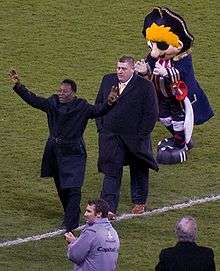
Yorkshire is officially recognised by FIFA as the birthplace of club football, as Sheffield F.C. who were founded in 1857 are certified as the oldest association football club in the world.[29] South Yorkshire hosted the first ever inter-club match and the first ever local derby on 26 December 1860; between Sheffield FC and Hallam FC.[30] South Yorkshire is also home to what is recognised by the Guinness Book of Records as the Oldest Ground in the World, Sandygate Road.[31] The Sheffield rules code was highly influential to the development of the FA's Laws of the Game, which is now the worldwide standard code for the game and happened to be drafted by Ebenezer Cobb Morley from Hull.[30]
In 1961 Rotherham United played in the first League Cup Final, when they lost 3–2 to Aston Villa in two legs, they won the first 2–0, but lost the second 3–0.[32] Yorkshire clubs compete in the English football league system. While they are by no means the most dominant footballing county, Yorkshire has produced several national league winners, some of whom have won the title more than once, including Sheffield Wednesday, Leeds United, Huddersfield Town and Sheffield United. Some players from Yorkshire have gone on to become some of the most highly regarded in the history of the game, including World Cup-winning goalkeeper Gordon Banks and two time European Footballer of the Year award winner Kevin Keegan.
Rugby
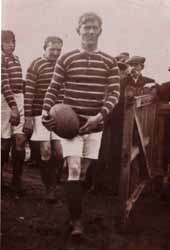
Originally Yorkshire clubs formed part of the Rugby Football Union which covered all of England under the same code. They took part in competitions such as the Yorkshire Cup. The sport was popular amongst the working class of the North, whilst in the South it was a middle-class man's game. This was a problem in the pre-professional era for the Yorkshire clubs, as the working class were limited by the need to earn a wage and did not have as much recreational time; it was against the rules for clubs to pay players.
In 1895 the rugby schism took place, creating the sport of rugby league in Huddersfield, West Riding of Yorkshire. The association they founded is still based in the North and is known as the Rugby Football League. Although some Yorkshire clubs now play rugby union, Rugby League is the main rugby focus for the county; of the 24 clubs who have competed in the Super League, 11 are from Yorkshire.
The five most decorated Yorkshire clubs in terms of league titles are Huddersfield Giants, Hull FC, Bradford Bulls, Hull Kingston Rovers and Leeds Rhinos. In total, six Yorkshiremen have been inducted into the British Rugby League Hall of Fame: Harold Wagstaff, Jonty Parkin, Roger Millward, Neil Fox, Billy Batten and Ellery Hanley.[33]
Ferret legging
The origin of ferret legging is disputed. The sport seems to have become popular among coal miners in Yorkshire, England, in the 1970s,[34][35] though some Scots claim it gained popularity in Scotland.[36] According to Marlene Blackburn of the Richmond Ferret Rescue League, ferret legging originated in public houses "where patrons would bet on who could keep a ferret in his pants the longest."[37] The sport may alternatively have originated during the time when only the relatively wealthy in England were allowed to keep ferrets used for hunting, forcing the animal poachers to hide their illicit ferrets in their trousers to avoid detection by gamekeepers.[38][39][40][41] This was also done by poachers and hunters to keep the animals warm in the cold weather.[36][39]
Retired miner Reg Mellor, from Barnsley,[42] set the new world record time of five hours and twenty-six minutes on 5 July 1981 at the Annual Pennine Show at Holmfirth, Yorkshire.[37][43][44][45] He had practised the sport since his youth, but had received no recognition until he set the new world record.[40] Mellor, who had hunted with ferrets in the dales outside of Barnsley for many years, had grown accustomed to keeping them in his trousers to keep them warm and dry when out working in the rain.[46] Mellor's "trick" was to ensure that the ferrets were well-fed before they were inserted into his trousers.[37]
In 1986, Mellor attempted to break his own record before a crowd of 2,500 spectators, intending to beat the "magic six-hour mark—the four-minute mile of ferret legging".[47] After five hours, most of the attendees had become bored and left; workmen arrived to dismantle the stage, despite Mellor's protests that he was on his way to a new record.[47] According to Adrian Tame of the Sunday Herald Sun, Mellor retired after that experience, "disillusioned and broken-hearted," but with his dignity and manhood intact.[48] Mellor had hoped to organise an annual national competition held in his home town of Barnsley, and offered a prize of £100 to anyone who could beat him.[34]
Others
In other sports, people from that county have also had success. "Prince" Naseem Hamed from Sheffield, was one of the most famous boxers of the 1990s; he won world championships in the Bantamweight (EBU) and Featherweight (IBF, IBO, WBC and WBO) divisions.
Yorkshire has produced several noted athletes; 100 metre runner Dorothy Hyman won three gold medals in the Commonwealth Games and one in the European Athletics Championships, middle-distance runner Peter Elliott also won gold at the Commonwealth Games. Adrian Moorhouse was a gold medal winning Olympian in swimming, earning victory at the 1988 Summer Olympics, he also won gold at three European Championships and three Commonwealth Games.
Yorkshire hosted the grand depart of the 2014 Tour de France. The county has produced many successful racing cyclists over the years. Notable male cyclists include Brian Robinson, the first British rider to finish and to win stages of the Tour de France, Barry Hoban, winner of eight Tour de France stages and two stages of the Vuelta a España, Malcolm Elliott, winner of the points classification at the 1989 Vuelta a España, Ed Clancy, a double Olympic and five time World Championship gold medallist on the track and Ben Swift, also a track cycling World Champion. Successful female cyclists include Beryl Burton, a double road cycling and five time track cycling World Champion, former individual pursuit World Champion Yvonne McGregor and World Championship track gold medallist and Olympic road racing silver medallist Lizzie Armitstead.
Literature
There are several instances of the county providing an important role in literature. Perhaps the most famous literacy association is that between Whitby in North Yorkshire and Bram Stoker's Dracula. When Stoker wrote the novel, he lived in Whitby, and parts of the novel are set there. It includes several stories of Whitby folklore such as the beaching of the Russian ship Dmitri, which became the basis of Demeter in the book.[49] Today there is a Dracula Museum in the town, celebrating the association.[50] In terms of poetry, one of the most well known from Yorkshire is Andrew Marvell from Winestead-in-Holderness, he was noted for writing metaphysical poetry during the 1600s, and his association with several other noted British poets from the era.[51][52]
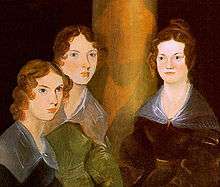
Then music, the mosaic of the air,
Did of all these a solemn noise prepare;
With which she gain'd the empire of the ear,
Including all between the earth and sphere.— Andrew Marvell, "Music's Empire"
The Brontë sisters – Anne, Charlotte and Emily—were all Yorkshirewomen born in Thornton and raised in Haworth, West Yorkshire.[53] Their novels, written in the mid 1800s, caused a sensation when they were first published and were subsequently accepted into the canon of great English literature. Amongst the most noted novels credited to the sisters are Anne's The Tenant of Wildfell Hall, Charlotte's Jane Eyre and Emily's Wuthering Heights.[53]
Ted Hughes wrote two collections that show his love for Yorkshire: Remains of Elmet (1979) and Elmet (1994), in which the ghost of Emily Brontë still haunts the moor.
In the present day, the most prominent Yorkshire presences in English literature are the playwright, author, actor, screenwriter and commentator Alan Bennett, born 1934 in Leeds, where much of his work is set, and the poet, playwright and screenwriter Tony Harrison, born three years later in the same city.
Music
Folk music
Yorkshire has a rich heritage of folk music and folk dance including particularly Long Sword dance.[54] Folk songs were collected in the region from the 19th century, and it probably had more attention than other northern counties, but its rich heritage of northern and industrial folk song was relatively neglected.[55] It was not until the second folk revival in the 1950s that Nigel and Mary Hudleston began to attempt to redress the balance, collecting a large number of Yorkshire songs between 1958 and 1978.[56]
Yorkshire folk song lacked the unique instrumental features of folk in areas like Northumbria and was chiefly distinguished by the use of dialect, particularly in the West Riding and exemplified by the song On Ilkla Moor Baht 'at, probably written in the later 19th century and using a Kent folk tune (almost certainly borrowed via a Methodist hymnal), but often seen as an unofficial Yorkshire anthem.[57] Most Yorkshire folk songs were not unique and tended to be adapted to fit local geography and dialect, as with probably the most commercially successful Yorkshire song, Scarborough Fair, recorded by Simon and Garfunkel, which was a version of the Scottish ballad The Elfin Knight.[58] One unusual piece of music is the unique choral folk song, probably derived from an 18th-century ballad, known as the Holmfirth Anthem or Pratty Flowers.[59]
The most eminent folk performers from the county are the Watersons from Hull, who began recording Yorkshire versions of folk songs from 1965, and members of which are still performing today.[60] Also famous is the Leeds-born musician Jake Thackray, who became famous in the 1970s for singing witty, often bawdy songs, many of which related to rural Yorkshire life, in a style derived from the French chansonnier tradition. His work led him to be described by some as the "Northern Noel Coward". Other Yorkshire folk musicians include Heather Wood (b. 1945) of the Young Tradition, the short-lived electric folk group Mr Fox (1970–2), The Deighton Family, Julie Matthews, Kathryn Roberts, and the Mercury Prize nominated Kate Rusby.[61]
Yorkshire has a flourishing folk music culture, with over forty folk clubs and thirty annual folk music festivals.[62] In 2007 the Yorkshire Garland Group was formed to make Yorkshire folk songs accessible online and in schools.[63]
Rock and pop music
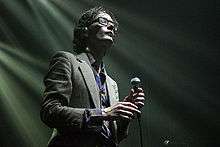
Yorkshire has played a significant part in popular music, starting with the unconventional Arthur Brown in the 1960s. During the following decade David Bowie, himself of a father from Tadcaster in North Yorkshire,[64] hired three musicians from Hull in the form of Mick Ronson, Trevor Bolder and Mick Woodmansey; together they recorded Ziggy Stardust and the Spiders from Mars, an album that went on to become highly regarded.[65]
Perhaps the most significant time for Yorkshire music in the modern era was the local post-punk scene of the 1980s, where the county produced several significant bands who went on to achieve success, including The Sisters of Mercy, The Cult, Gang of Four, The Human League, Def Leppard, Heaven 17, New Model Army, Soft Cell, Chumbawamba, The Wedding Present, The Mission, The Housemartins,[66] The Beautiful South and The Comsat Angels.
Pulp from Sheffield had a massive hit in the form of "Common People" during 1995, a song focusing on working-class northern England life.[67] The 2000s saw popularity for indie rock and post-punk revival bands from the area with the Kaiser Chiefs and the Arctic Monkeys, the latter holding the record for the fastest-selling debut album in British music history with Whatever People Say I Am, That's What I'm Not.[68]
Yorkshire has also contributed heavily to the emergence of the electronic music industry from the 1990s until the present day. The nightclubs of Leeds and Sheffield helped to build the foundations for record labels such as Warp Records. The region has also been influential in the development of bassline, producing a huge hit with T2's "Heartbroken" in 2007, and has produced grime crews such as Scumfam. Music in these and related genres has been championed by Toddla T, a Sheffield-born DJ on BBC radio.
Art
Particularly notable international artists from Yorkshire included Henry Moore (sculptor) and David Hockney (painter). In 1925, the Fylingdales Group of Artists was founded at Denton Hawley’s studio in Robin Hood's Bay.[69] See also a list of artists and sculptors from Yorkshire.
Film and television

Three prominent British television shows filmed in (and based around) Yorkshire are sitcom Last of the Summer Wine, drama series Heartbeat and Emmerdale, the latter two of which are produced by Yorkshire Television. All Creatures Great and Small, based on books by James Herriot, was set in Yorkshire and exterior shots were filmed there. The television drama Downton Abbey, although set in Yorkshire, is actually filmed in Berkshire and at Ealing Studios, London. Last of the Summer Wine, in particular, is noted for holding the record of longest-running comedy series in the world, from 1973 until 2010.[70] Open All Hours and its continuation Still Open All Hours are set and filmed in Doncaster.
Several noted films are set in Yorkshire, including Kes, Four Lions, This Sporting Life, Calendar Girls, God's Own Country (2017 film) and Room at the Top. A comedy film set in Sheffield named The Full Monty, won an Academy Award and was voted the second best British film of all-time in a 2007 poll by Radio Times.[71][72] Threads, a docu-drama about nuclear winter, was set and filmed in Sheffield. The county is also referenced in Monty Python's The Meaning of Life during a segment on birth where title card read, "The Miracle of Birth, Part II — The Third World". The scene then opened into a mill town street, subtitled "Yorkshire".[73] Monty Python were also known to perform the Four Yorkshiremen sketch live, which first featured on At Last the 1948 Show.[74]
See also
References
- Notes
- "John Major – Brighton Rally". The Conservatives Party. 29 May 2001. Archived from the original on 22 November 2006. Retrieved 30 November 2014.
He's a shrewd, straight-talking Yorkshireman – not English, mind you, Yorkshire
- Kellett, Arnold (January 1994). The Yorkshire Dictionary of Dialect, Tradition and Folklore. Smith Settle. ISBN 1-85825-016-1.
- Taylor, G.P. (2 June 2006). "God's own county". The Guardian. London. Retrieved 30 November 2014.
- "Yorkshire Pride". YorkshirePride.co.uk. 24 October 2007.
- Kellett, Arnold. Yorkshire Dialect Classics. p. 15.
- "Regimental Day – Yorkshire Day". The Army. Archived from the original on 6 October 2007. Retrieved 30 November 2014.
- "Artist v. Factories". Time. New York. 16 August 1937. Retrieved 30 November 2014.(subscription required)
- "Yorkshire Lancashire - Martin Hickes". sites.google.com.
- "What does the saying "Where there's muck there's brass" mean?". Blurtit.com. 21 December 2006. Archived from the original on 14 November 2007. Retrieved 30 November 2014.
- Titley, Chris. "Yorkshire? Now you're talking!". York: The York Press. Archived from the original on 23 January 2008. Retrieved 24 October 2007.
- "Tyke". Collins English Dictionary. Retrieved 24 October 2007.
- "The National Anthem of Yorkshire 'God's own county'". DKSnakes.co.uk. Archived from the original on 12 September 2007. Retrieved 24 October 2007.
- "Curd Cheesecakes". Yorksgen Recipes. Retrieved 25 October 2007.
- "Yorkshire curd tart". BBC. Retrieved 23 October 2014.
- Wilson, Carol (25 September 2000). "Yorkshire Parkin". About Food. Archived from the original on 7 June 2007.
- "Pomfret Cakes (The story of Pontefract & Liquorice)". Wakefield Council. Archived from the original on 17 November 2009. Retrieved 12 October 2009.
- "Yorkshire Recipes: Ginger Beer". Wensleydale.org. Archived from the original on 9 October 2007. Retrieved 25 October 2007.
- Cumming, Ed (31 January 2016). "Mysteries of the Rhubarb Triangle, revealed by Martin Parr". The Guardian. Retrieved 31 January 2018.
- "EU name status". BBC News. BBC. 25 February 2010. Retrieved 25 February 2010.
- Hemmings, Julie (20 September 2007). "Safeguard for chocolate heritage". Yorkshire Post. Leeds.
- "Chocolate history". Visit York. Archived from the original on 24 May 2010. Retrieved 12 October 2009.
- "Fifty six good reasons for taking a beer break in Yorkshire". Line Studio. Retrieved 25 October 2007.
- "Yorkshire finishes twelfth in medals table at Olympics". The Guardian. 13 August 2012. Retrieved 14 August 2012.
- "Yorkshire County Cricket Club". Napit.co.uk. Retrieved 25 October 2007.
- "Yorkshire bat out Roses stalemate". BBC Sport Online. 19 May 2006.
- Rigg, John (24 August 2001). "Yorkshire Win County Championship". Dalesview.co.uk. Archived from the original on 21 July 2002.
- Dobell, George. "Dickie Bird". ESPN Cricinfo. Retrieved 12 October 2009.
- "Pelé joins Sheffield celebrations". BBC. 25 June 2015.
- "Famous sons and daughters". Sheffield FC. Archived from the original on 27 September 2007. Retrieved 25 October 2007.
- Harvey, Adrian (January 2005). Football, the First Hundred Years: The Untold Story of the People's Game. Routledge. ISBN 0-415-35018-2.
- Power, Rob (September 2003). "The Ultimate A-Z of Sheffield". BBC South Yorkshire. Archived from the original on 8 April 2004.
- "The complete guide to the history of the League Cup: Roll Of Honour". Coors Brewers. 2007. Archived from the original on 11 January 2010.
- "Rugby League Hall of Fame". RLHallofFame.org.uk. Archived from the original on 11 October 2007. Retrieved 25 October 2007.
- Kershaw, Ronald (31 December 1980). "Mr Mellor sets scene for a Yorkshire test of the ferret-legging custom". The Times. p. 2. Retrieved 12 August 2009.
- Greene, Jerry (31 December 1995). "Feeling Bowled Over? I Have A Cure – Sort Of". Orlando Sentinel. p. C1.
- Nycz, Brent (19 November 2008). "Ferret Legging: Not Just for Brits Anymore". Fordham Observer. Archived from the original on 15 May 2010. Retrieved 14 August 2009.
- Wasson, Bill (29 October 2006). "Intimate sport of ferret legging / At annual Highland event, contestants put animal down their pants, then wait, pray". Richmond Times-Dispatch. p. B.1.
- "Countryside day may be annual event". Northern Echo. 4 January 2005. Archived from the original on 10 September 2009. Retrieved 12 August 2009.
- George, Isabel (9 February 2002). "They've been companions to royalty and poachers, prized for their hunting skills and even used to lay underground cables. Now ferrets are being cast in a new role – as pets. And they're surprisingly good at that". The Guardian. p. F3.
- "Recognition by squirming is his goal". The Ledger. 8 September 1981. p. 5C. Archived from the original on 25 January 2013. Retrieved 13 August 2009.
- Eaton, Lynn (4 October 1994). "A fesnyng of ferrets: Not only poachers love the ferret. Lynn Eaton calls in on the capital's one-man rescue service". The Independent. London. Retrieved 14 August 2009.
- Hattenstone, Simon (14 August 2008). "In Praise Of The North". The Guardian.
- Gould, Philip J.; Laue, Ralf (2004). Book of Alternative Records. Metro Publishing. ISBN 1-84358-126-4.
- Gordon, Jim (16 July 2002). "A 'sport' unlikely to draw spectators". Post-Tribune. p. A2.
- "Ned Creighton eyes the lawmakers". Kingman Daily Miner. 4 April 1983. p. 2. Archived from the original on 21 July 2012. Retrieved 4 September 2009.
- Katz 2001, p. 6
- Katz 2001, p. 9
- Tame, Adrian (19 January 2003). "Ferreting out my hero". Sunday Herald Sun. p. 75.
- "Coast: Point 6 – Stoker". BBC North Yorkshire. 29 September 2006.
- "Whitby Museum". Dracula-In-Whitby.com. Archived from the original on 15 November 2007. Retrieved 25 October 2007.
- "The Life of Andrew Marvell (1621–1678)". Luminarium.org. Retrieved 25 October 2007.
- "Poets' Corner – Andrew Marvell – Selected Works IV". TheOtherPages.org. Retrieved 25 October 2007.
- "Biography of Family". BronteFamily.org. Retrieved 25 October 2007.
- Sharp, C. J. (2003). Sword Dances of Northern England Together with the Horn Dance of Abbots Bromley. Kessinger.
- Broughton, S.; Ellingham, M.; Trillo, R.; Duane, O.; Dowell, V. (1999). World Music: The Rough Guide. Rough Guides. p. 67.; Ingledew, C.J.D. (1860). Ballads and Songs of Yorkshire. London.; Forshaw, C. (1892). Holyrod’s Collection of Yorkshire Ballads. London.
- Hudleston, N.; Hudleston, M. (2001). Gordon, M.; Adams, R. (eds.). Songs of the Ridings: The Yorkshire Musical Museum. G. A. Pindar and Son. and Davenport, P., ed. (1998). The South Riding Songbook: Songs from South Yorkshire and the North Midlands. South Riding Folk Network.
- Kellett, A. (1988). On Ilkla Mooar baht 'at: the Story of the Song. Smith Settle.
- Child, F. J. (1965). The English and Scottish Popular Ballads. 1. New York: Dover Publications. p. 8.
- "The Holmfirth Anthem or Pratty Flowers". Journal of the Folk Song Society. VI: 9. 1922.
- Nidel, R. (2005). World Music: The Basics. Routledge. p. 90.
- Nidel, R. (2005). World Music: The Basics. Routledge. pp. 90–1.
- "Folk and Roots". Archived from the original on 9 February 2013. Retrieved 12 October 2009.
- Murphy, Lizzie (31 August 2007). "Folk songs of traditional Yorkshire to be celebrated on group's heritage website". Yorkshire Post. Leeds.
- "Episode for 29 November 2003". Parkinson (TV series).
- Tyrangiel, Josh; Light, Alan (13 November 2006). "The All-TIME 100 Albums". Time. New York.
- "Will the gods come from Leeds?". BBC Leeds. Retrieved 25 October 2007.
- "Common People". BBC.co.uk. Retrieved 25 October 2007.
- "Arctic Monkeys win Mercury Prize". BBC News Online. London. 5 September 2006.
- "Fylingdales Group". Artist Biographies – British and Irish Artists of the 20th Century. UK. Retrieved 10 July 2020.
- "Summer Wine – The Story". Summer-Wine.com. Archived from the original on 4 July 2007. Retrieved 25 October 2007.
- "Monty Python's 'Life of Brian' tops Best British Movie list". Yahoo.com. 24 July 2007. Archived from the original on 5 January 2008.
- "Life of Brian is top British film". Metro. 23 July 2007. Retrieved 23 August 2018.
- Canby, Vincent (31 March 1983). "Monty Python's The Meaning of Life (1983)". The New York Times. Archived from the original on 19 May 2011. Retrieved 25 October 2007.
- "The 'Four Yorkshiremen' Sketch". Ayup! Online Magazine. Archived from the original on 13 October 2007. Retrieved 25 October 2007.
- Bibliography;
- Katz, Donald (2001) [1987]. King of the Ferret Leggers and Other True Stories. New York: Random House. ISBN 0-8129-9152-4.CS1 maint: ref=harv (link)